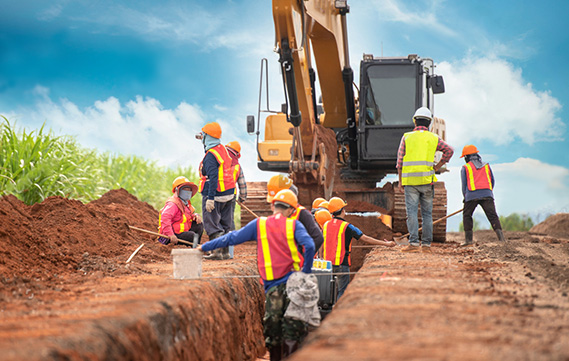In construction and excavation projects, the safety of workers in trenches is paramount. To mitigate risks and ensure a secure work environment, it is crucial to understand trench safety requirements, OSHA regulations, and more.
In this article, we’ll cover the supplies and equipment needed for an effective trench safety checklist. We’ll also provide you with a guide on trench safety requirements. By implementing these measures, you can protect workers and promote a safer workplace.
Trench Safety Equipment and Supplies
Utilizing the right safety equipment is key to protecting workers from potential dangers. Knowing how different tools work together can help create a safer environment on any job site.
1. Personal Protective Equipment (PPE)
Working in trenches requires more than common sense – it demands proper protection. To ensure safety, workers must wear the necessary protective gear such as:
- High-visibility vests
- Boots with steel toes
- Ear and eye protection
- An air filtration device (if hazardous gasses are present)
With these safeguards in place, employees can confidently work around dangerous conditions without compromising their health or well-being.
2. Excavation Equipment
When digging trenches, appropriate excavation equipment is required. This typically includes an excavator sized according to the job requirements.
You’ll also need a loader to remove spoils or bring in bedding material. Additionally, a bedding box (or stone box) should be available to keep materials readily accessible during the excavation process.
3. Trench Box Safety & Installation Equipment
Installing a trench box necessitates having a suitable rigging capacity that exceeds the weight of the trench box. Commonly, wire rope or chain slings are used for this purpose. The proper rigging equipment ensures the secure installation of the trench box, providing protection against cave-ins.
4. Entry and Exit Equipment
Workers must exercise caution when entering and exiting a trench. Using ladders can help meet safety standards to ensure their protection. In some cases, hoists may also be necessary for safe entry and exit from the depths of the excavation.
Trench Safety Requirements
Trenches present a variety of hazardous conditions, such as cave-ins and overhead issues. This can be especially dangerous if the proper safety precautions are not taken. To protect workers from these risks, you must abide by guidelines given by The Occupational Safety and Health Administration (OSHA).
OSHA Trench Safety
OSHA plays a vital role in ensuring workplace safety, including trenching and excavation operations. OSHA has established specific regulations and requirements such as:
Depth and Width Requirements
OSHA sets criteria for trenches based on their depth and width. For example, trenches deeper than five feet must have protective systems in place. That is unless the excavation is made entirely in stable rock.
Competent Person Inspection
Employers have a responsibility to ensure the safety of their workers by having competent persons inspect trenches daily for hazardous conditions. These individuals are qualified to identify any potential dangers and take immediate corrective action.
Contractors working on underground projects need to abide by stringent safety regulations. They must have a trained competent person on the site at all times. The competent individual must inspect all equipment regularly, especially shoring (trench boxes).
Manufacturers of trench boxes must indicate the capacities for their products in A, B, and C soil conditions. It’s up to the end user to not only adhere but also regularly check that no damage affects these capacities. Otherwise, they risk fines and jeopardizing employee safety.
Protective Systems
Trenches must be properly protected using one of the following methods:
- Sloping: this involves cutting the trench walls back at an angle to prevent cave-ins.
- Shoring: utilizes supports such as aluminum hydraulic or mechanical systems to prevent soil movement.
- Shielding: consists of using trench boxes or other types of protective structures to safeguard workers inside the trench.
- Benching: an effective technique involving digging the sides of a hole into horizontal levels or steps, offering additional security and stability.
Access and Egress
OSHA requires quick and easy access points every 25 feet. These entry and exit points must be clear of any potential blockages. This way personnel can evacuate quickly in case of an emergency.
Prioritizing Trench Safety for a Safer Work Environment
Trench safety is a collective responsibility. Employers, workers, and safety professionals must work together to ensure compliance with regulations and ongoing training. By doing so, we can create a workplace where every worker is protected. With the right supplies, hazards are minimized and the risks associated with working in trenches are effectively managed.
Protect your team and projects with the best in safety equipment. Submit a request today to get access to high-quality trench boxes and other protective gear.


